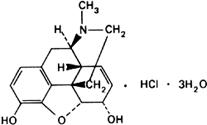Monographs: Pharmaceutical substances: Morphine hydrochloride (Morphini hydrochloridum)
Molecular formula. C17H19NO3,HCl,3H2O
Relative molecular mass. 375.9
Graphic formula.

Chemical name. 7,8-Didehydro-4,5α-epoxy-17-methylmorphinan-3,6α-diol hydrochloride (1:1) (salt) trihydrate; CAS Reg. No. 6055-06-7.
Description. Colourless, needle-like crystals or a white, crystalline powder; odourless.
Solubility. Soluble in 25 parts of water; slightly soluble in ethanol (~750 g/l) TS; practically insoluble in ether R.
Category. Analgesic.
Storage. Morphine hydrochloride should be kept in a tightly closed container, protected from light.
Additional information. Even in the absence of light, Morphine hydrochloride is gradually degraded on exposure to a humid atmosphere, the decomposition being faster at higher temperatures.
Requirements
Definition. Morphine hydrochloride contains not less than 98.0% and not more than 101.0% of C17H19NO3,HCl, calculated with reference to the dried substance.
Identity tests
A. To 5 mL of a 1 mg/mL solution add 3 drops of a freshly prepared potassium ferricyanide (10 g/l) TS and 1 drop of ferric chloride (25 g/l) TS; a bluish green colour is produced.
B. To 5 mL of a 1 mg/mL solution add 1 mL of hydrogen peroxide (~60 g/l) TS, 1 mL of ammonia (~100 g/l) TS, and 1 drop of copper (II) sulfate (80 g/l) TS; a transient red colour is produced.
C. To about 1 mg add 0.5 mL of sulfuric acid (~1760 g/l) TS containing 1 drop of formaldehyde TS; a purple colour is produced, which changes quickly to violet.
D. Dissolve a few mg in 5 mL of water, add 1 drop of hydrochloric acid (~70 g/l) TS and 1 mL of potassium iodobismuthate TS2; an orange or orange-red precipitate is produced immediately.
E. A 20 mg/mL solution yields reaction B, described under 2.1 General identification tests as characteristic of chlorides.
Specific optical rotation. Use a 20 mg/mL solution and calculate with reference to the dried substance;  = -109° to -115°.
= -109° to -115°.
Sulfated ash. Not more than 1.0 mg/g.
Loss on drying. Dry to constant weight at 105°C; it loses not less than 115 mg/g and not more than 150 mg/g.
Acidity. Dissolve 0.2 g in 10 mL of carbon-dioxide-free water R, and titrate with sodium hydroxide (0.02 mol/l) VS, using methyl red/ethanol TS as indicator; not more than 0.2 mL is required to obtain the midpoint of the indicator (orange).
Meconate. Dissolve 0.2 g in 5 mL of water, add 5 mL of hydrochloric acid (~70 g/l) TS and a few drops of ferric chloride (25 g/l) TS; no red colour is produced.
Related alkaloids. Transfer about 0.5 g, accurately weighed, to a separator, add 15 mL of water, 2 mL of sodium hydroxide (10 g/l) TS, and 10 mL of chloroform R. Shake, allow to separate and transfer the chloroform layer to another separator. Repeat the extraction with further quantities of chloroform R, each of 10 mL. Wash the combined chloroform solutions with 4 mL of sodium hydroxide (10 g/l) TS and then twice with water, using 5 mL each time. Separate the chloroform layer and evaporate it carefully to dryness on a water-bath. Add to the residue thus obtained 10 mL of sulfuric acid (0.01 mol/l) VS, heat until dissolved, cool, add 1 drop of methyl red/ethanol TS, and titrate the excess acid with sodium hydroxide (0.02 mol/l) VS; not less than 8.75 mL is required to obtain the midpoint of the indicator (orange).
Noscapine. Dissolve 0.05 g in 2 mL of sulfuric acid (~1760 g/l) TS and heat the solution on a water-bath; no violet colour is produced.
Assay. Dissolve 0.300 g in a mixture of 5 mL of hydrochloric acid (0.01 mol/L) VS and 30 mL of dehydrated ethanol R. Carry out a potentiometric titration using sodium hydroxide (0.1 mol/L) VS, as described under 2.6 Non-aqueous titration. Read the volume added between the two points of inflexion.
1 mL of sodium hydroxide (0.1 mol/L) VS is equivalent to 32.18 mg of C17H19NO3,HCl.
Additional requirement for Morphine hydrochloride for parenteral use
Complies with the monograph for "Parenteral preparations".